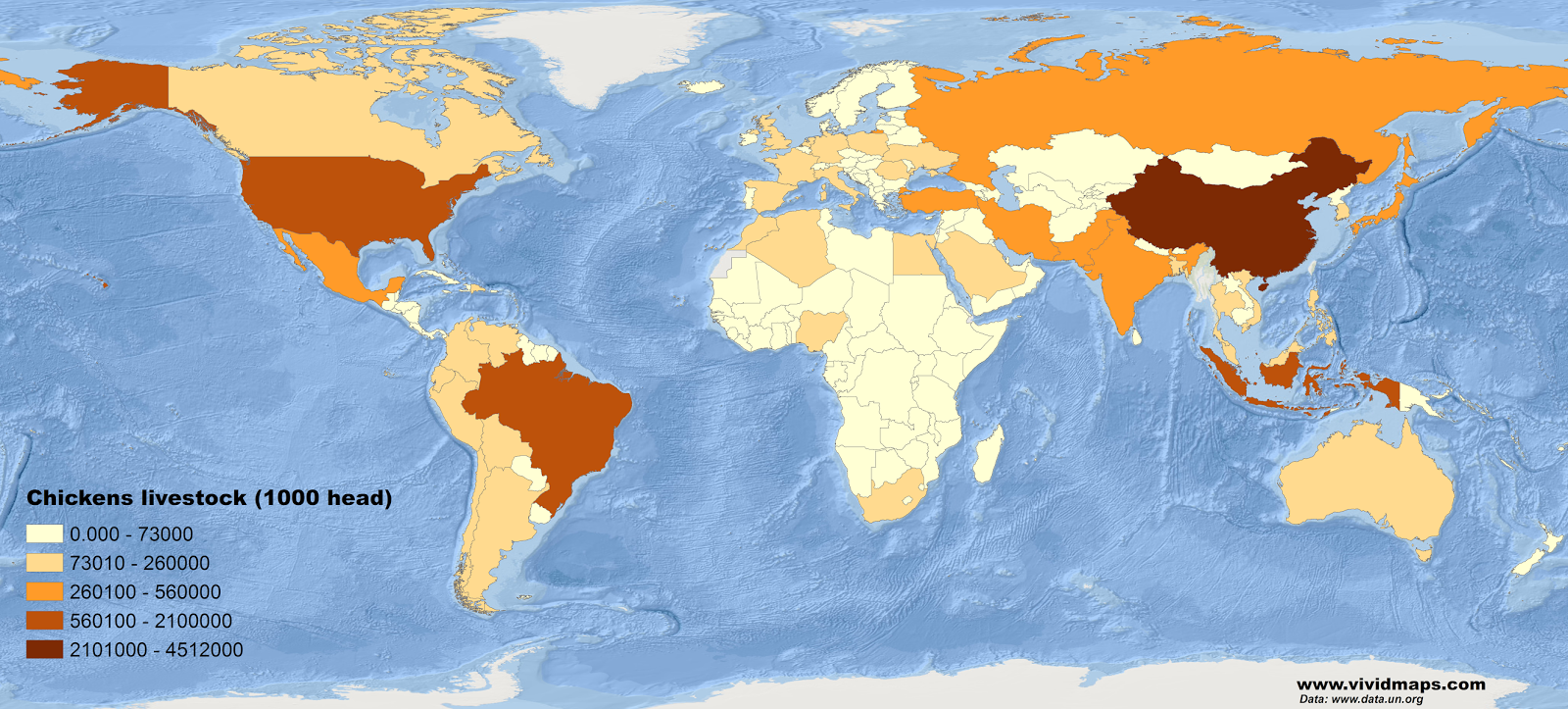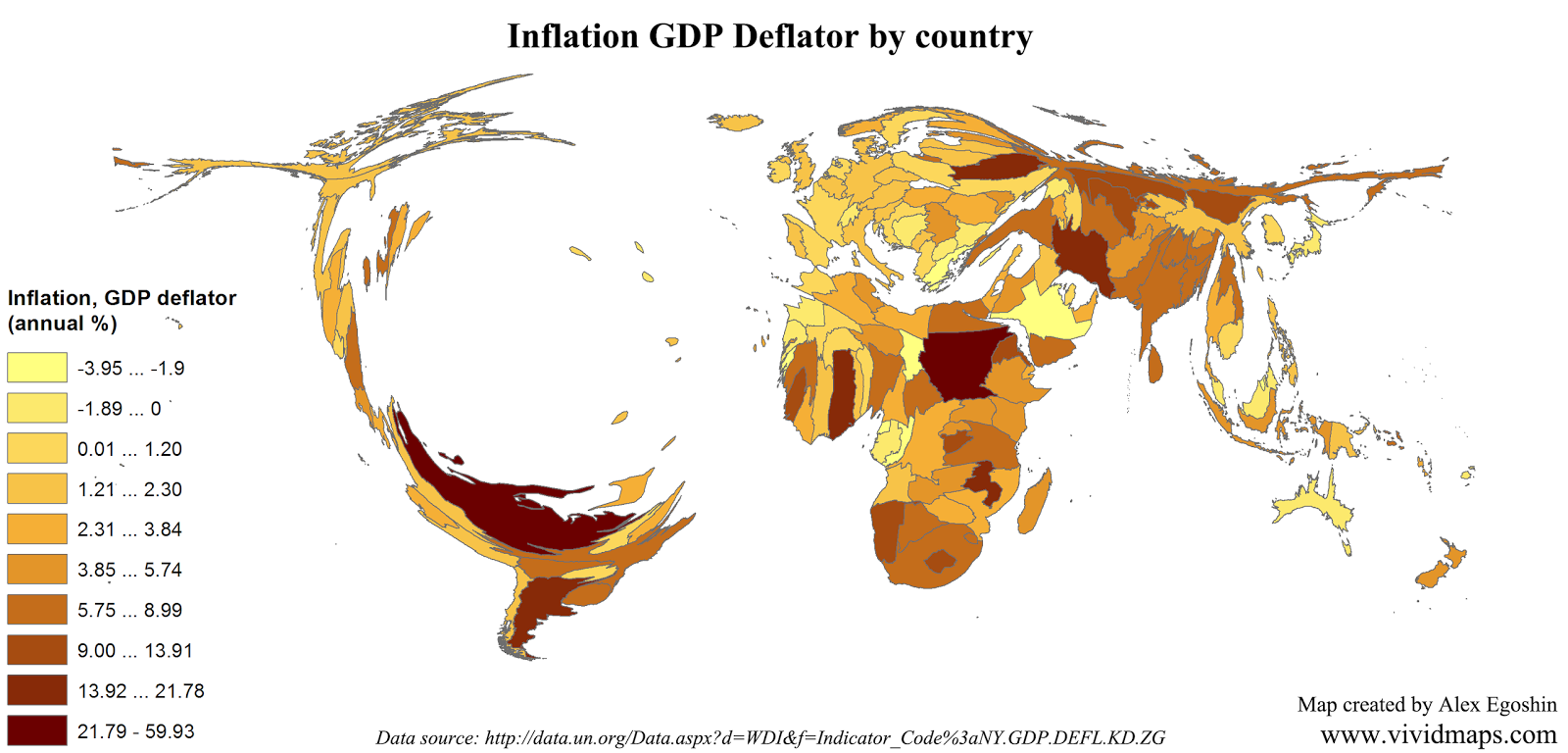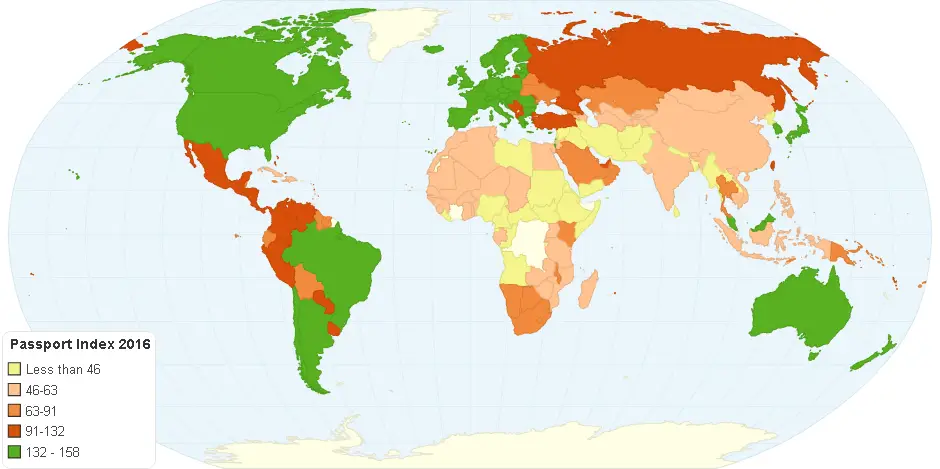Mapped: What the Boogeyman Looks Like Across the Globe
Around the world, there are mythical creatures meant to scare children into doing the right thing and behaving well. However, often they become the subject of terrifying nightmares.
The Boogeyman. Krampus. Ninki Nanka. These frightening creatures are found all over the world, where they are available to enforce discipline when necessary.
Fortunately, just mentioning of a local boogeyman’s name — the Bunyip in Australia, China’s Grandmother Tiger — is sure to bring an errant preschooler into line before they can be whipped away in a sack/eaten/soul-sucked.
Fortunately, just mentioning the local boogeyman’s name — like Australia’s Bunyip or China’s Grandmother Tiger — is often enough to rein in a mischievous preschooler before they can be whipped away in a sack, eaten or soul-sucked.
But could these mythical creatures actually have a positive impact on your kids? It depends on how you invoke the beast: flat-out terrifying Junior into doing the right thing is not recommended. “Some parents try to scare children into following rules,” say researchers at Purdue University. “It is not a very effective way to control children’s behavior. Fear uses the lower levels of the brain, so children do not learn to think when parents use fear.”
But can these mythical creatures actually have a positive impact on your children? It all comes down to how you introduce them. Scaring kids into behaving correctly isn’t recommended. According to researchers at Purdue University, “Some parents try to scare children into following rules. It is not a very effective method to control children’s behavior. Fear engages the lower levels of the brain, so kids do not learn to think when parents use fear.”
On the other hand, mythmaking can be a fun and fascinating way to diffuse a potential flare-up. According to psychologists, allegorical figures and storytelling help children navigate their emotions and better understand the workings of the world.
To help fuel your imagination and provide a cast for your cautionary tales, TheToyZone scoured books and articles to uncover examples of local boogeymen from around the world. Explore the world map below to discover more about these “local childhood law enforcers” from nearly every country of the globe.
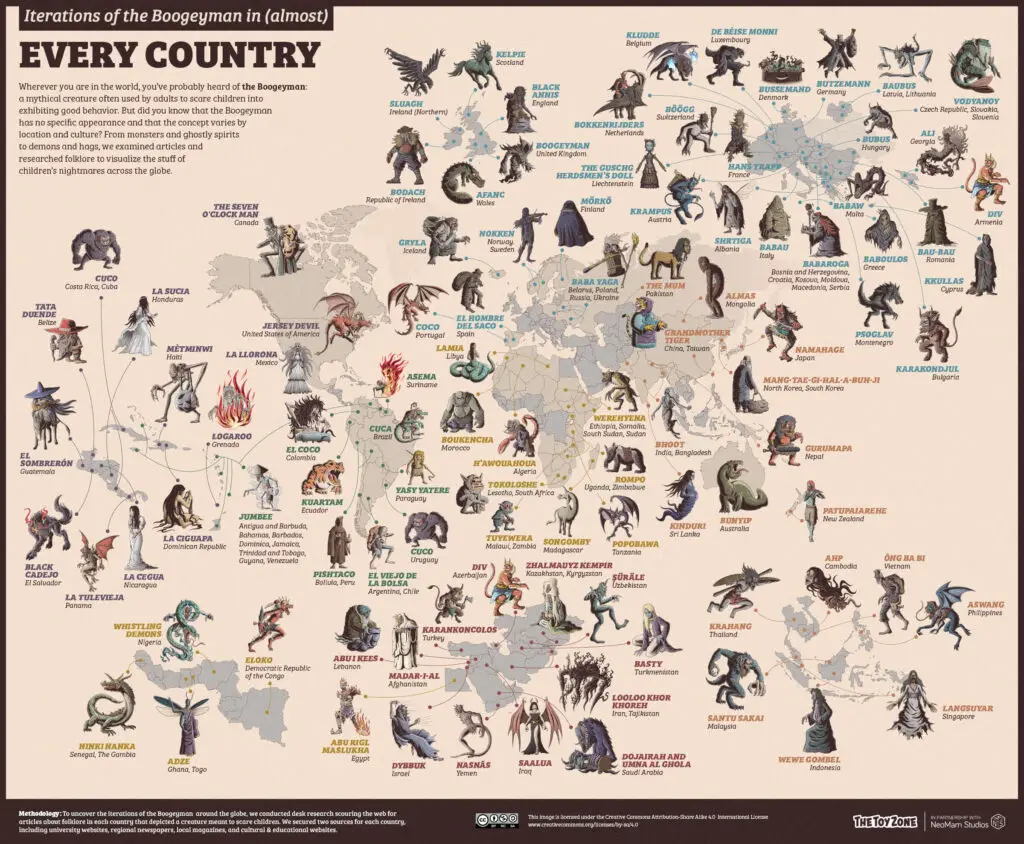
Table of Contents
North America
Common in English-speaking Caribbean states, such as the Bahamas, Barbados, and Trinidad and Tobago, the Jumbee is a child-preying, malevolent entity that usually appears as a humanoid zombie-like creature surrounded by mist. Meanwhile, in Canada, The Seven O’clock Man heaves around a sack of children, threatening to snatch any child not in bed by 7 pm.
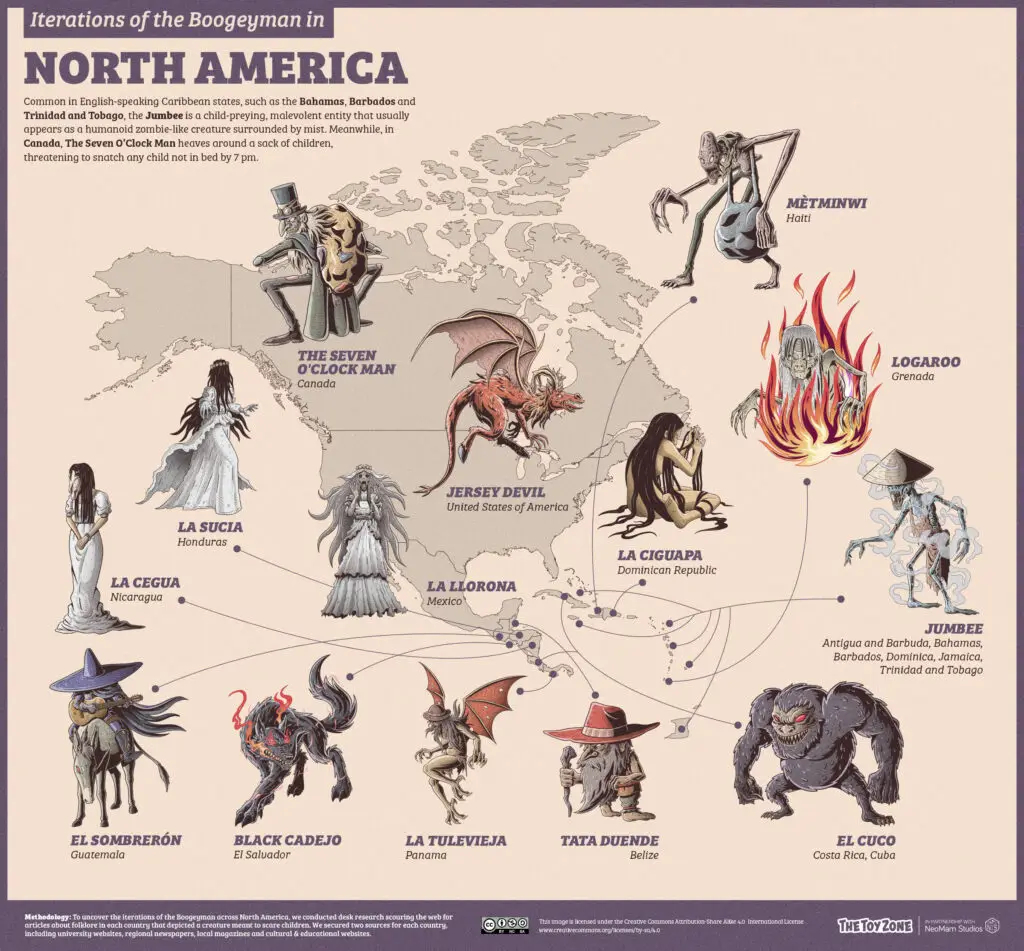
| Country | Boogeyman Name | Description |
|---|---|---|
| Antigua and Barbuda | Jumbee/Jumbie | A malevolent evil spirit who was evil while alive. It preys on disobedient children. Usually appeared as a humanoid, zombie-like spirit that is surrounded in mist. |
| Bahamas | Jumbee | A malevolent evil spirit who was evil while alive. It preys on disobedient children. Usually appeared as a humanoid, zombie-like spirit that is surrounded in mist. |
| Barbados | Jumbee | A malevolent evil spirit who was evil while alive. It preys on disobedient children. Usually appeared as a humanoid, zombie-like spirit that is surrounded in mist. |
| Belize | Tata Duende | Portrayed as a guardian of animals and the forest who is about 3ft tall old man with a large beard. The Duende would lure children deeper into the woods and the only way they could escape him would be to hide your thumbs and show only your four fingers. |
| Canada | The Seven O’Clock Man | Children were warned to go to bed before 7pm or they would be snatched away by the monster. He is most commonly depicted as an old man with a heavy sack over his shoulders. |
| Costa Rica | El Cuco | Originating from a children’s lullaby, it takes no specific form and is used by parents to scare the fear of god in children. |
| Cuba | El Cuco | Originating from a children’s lullaby, it takes no specific form and is used by parents to scare the fear of god in children. |
| Dominica | Jumbie | A malevolent evil spirit who was evil while alive. It preys on disobedient children. Usually appeared as a humanoid, zombie-like spirit that is surrounded in mist. |
| Dominican Republic | La Ciguapa | A woman with long dark hair and backwards feet that preys on lonely farmers. Young boys and girls are warned against venturing out into the woods alone because La Ciguapa will get them. |
| El Salvador | Black Cadejo | One of two dog-like spirits. The Black Cadejo is the evil spirit who wanders at night looking for people wandering at night to steal their soul. Parents warn of El Cadejo to stop children wandering out at night. |
| Grenada | Loogaroo | A shapeshifting demonic character of Caribbean folklore. A class of Jumbie, it comes out at night to suck the blood of its victim. Looks like an old woman or hag. |
| Guatemala | El Sombreron | A goblin-like creature with a large sombrero. With an obsession for braiding hair, he arrives in town with a pack of mules and kidnaps young girls. |
| Haiti | Metminwi | Haunts streets after dark and preys on anyone foolish enough to be out at night. Is a large thin humanoid measuring two stories tall. |
| Honduras | La Sucia | A ghostly spirit of a young girl who died on her wedding day. She sends people, mostly men, into a manic frenzy turning them insane. Is used as a precaution for children. |
| Jamaica | Jumbee/Duppy | A malevolent evil spirit who was evil while alive. It preys on disobedient children. Usually appeared as a humanoid, zombie-like spirit that is surrounded in mist. |
| Mexico | La Llorona | The story of La Llorona is told to children to encourage them not to wander alone into the dark. Spanish for the weeping women, a tall thin spirit blessed with beauty who mourns children she drowns. |
| Nicaragua | La Cegua | A beautiful woman with a delicate veil that appears on lonely, dark roads. The horse she rides is a specter and her face becomes a horse’s skull when met by a man. Children are warned of her to avoid going out at night. |
| Panama | La Tulevieja | A scorned woman who abandoned her baby to hide an affair. She kidnaps children who were bratty. |
| Trinidad and Tobago | Jumbee/Jumbie | A malevolent evil spirit who was evil while alive. It preys on disobedient children. Usually appeared as a humanoid, zombie-like spirit that is surrounded in mist. |
| United States of America | Jersey Devil | A creature with a horse’s head and glowing red eyes, it comes out at night to scare children out late and it terrorises people in the Pine Barrens of New Jersey. |
South America
For children living in Argentina, the threat of El Viejo De La Bolsa would ensure that they were back home on time. Most often depicted as a tall and scrawny old man, this Boogeyman roams the streets at night with a large sack, looking for children to snatch. Elsewhere, in Peru and Bolivia, the Pishtaco lurks, ready to descend on unsuspecting victims. Deriving from ‘pishtay,’ which means to ‘behead, cut the throat, or cut into slices,’ this vampire-like creature feeds on human flesh.
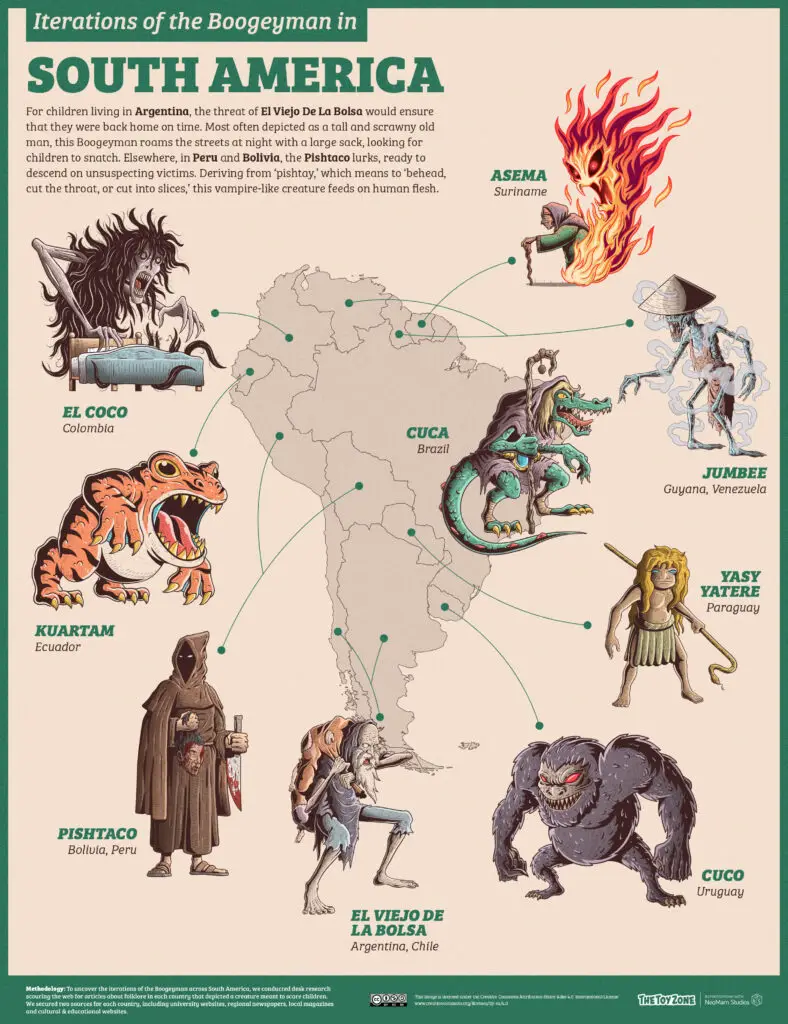
| Country | Boogeyman Name | Description |
|---|---|---|
| Argentina | El Viejo De La Bolsa | Depicted as an old man with a large bag that walks around the neighborhood in the evenings, looking for children that are not home by dinner time. |
| Bolivia | Pishtaco | Akin to the vampire, the Pishtaco lures its victims into the jungle and sucks out their body fat and slits their throat. Usually looks like a dishevelled, unkempt foreign man. |
| Brazil | Coco/Cuca | A ugly woman who robs children while taking the form of a crocodile. Used to scare children who don’t want to go to sleep. |
| Chile | El Viejo Del Saco | Depicted as an old man with a large bag that walks around the neighborhood in the evenings, looking for children that are not home by dinner time. |
| Colombia | El Coco | A ugly woman who devours children leaving no trace. Used to scare children who don’t want to go to sleep. |
| Ecuador | Kuartam | A man-eating toad. It serves as a warning to children to be respectful of the jungle and to not wander off on their own. |
| Guyana | Jumbee | A malevolent evil spirit who was evil while alive. It preys on disobedient children. Usually appears as a humanoid, zombie-like spirit that is surrounded in mist. |
| Paraguay | Jasy Jatare/Yasy Yatare | The lord of siesta. He is invisible to everyone but children. He lures children, who are not sleeping, into the forest. Looks like a shorter man with long golden hair and blue eyes. |
| Peru | Pishtaco | Akin to the vampire, the Pishtaco lures its victims into the jungle and sucks out their body fat and slits their throat. Usually looks like a dishevelled, unkempt foreign man. |
| Suriname | Asema | A shapeshifting demonic character of Caribbean folklore. A class of Jumbie, it comes out at night to suck the blood of its victim. Looks like an old woman or hag. |
| Uruguay | Cuco | A children’s rhyme of a brown hairy monster that spawned from a coconut. |
| Venezuela | Jumbee | A malevolent spirit who was evil while alive. It preys on disobedient children. Usually appeared as a humanoid, zombie-like spirit that is surrounded in mist. |
Europe
Originating in 15th-century England, the Boogeyman was invented as a method of deterring children from doing bad or ill-advised things, like going into dark woods. However, in Austria, children are given a festive fright by The Krampus, the infamous half-goat/half-demon creature that punishes misbehaving children at Christmas. Elsewhere, in the Czech Republic, Slovakia, and Slovenia, an algae-covered man with a frog’s head (known as the Vodyanoy) is a vindictive water spirit that revels in drowning humans.
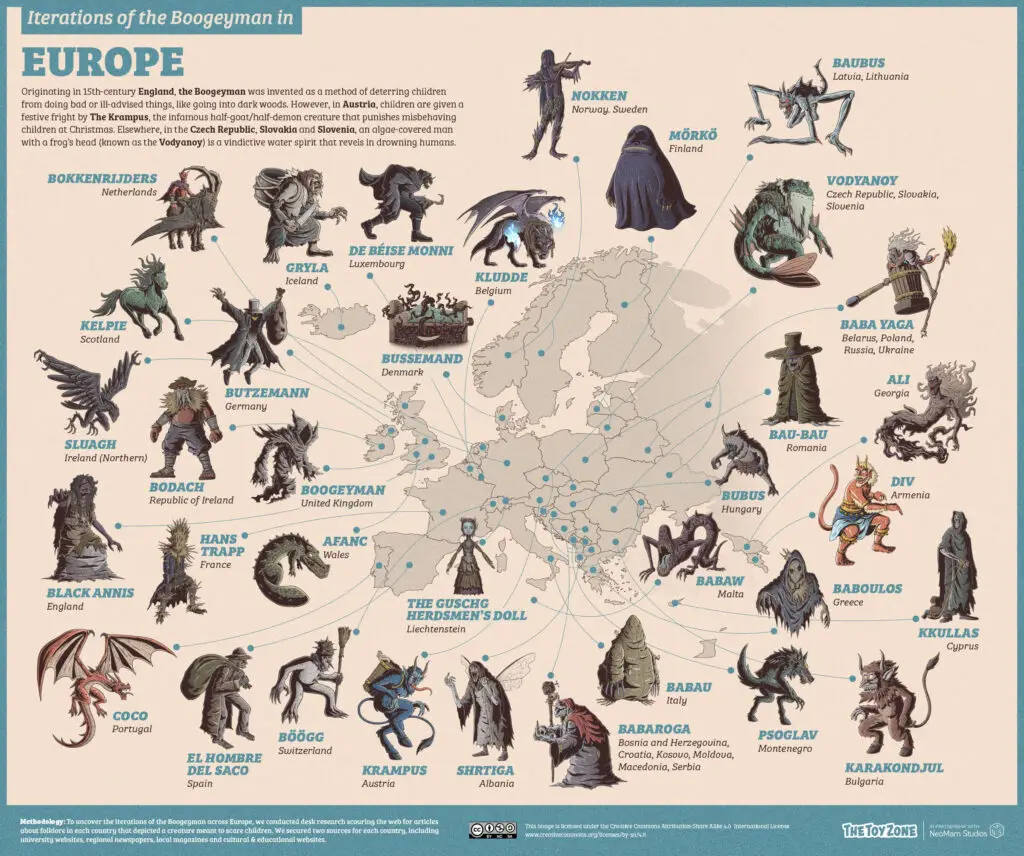
| Country | Boogeyman Name | Description |
|---|---|---|
| Albania | Shrtiga | Vampiric witch that sucks the blood from infants and children. It would then turn into a flying insect to escape. |
| Armenia | Div | An islamic demon. They have the ability to shapeshift and do the opposite of what they are told. It eats children and tries to kidnap women to marry. Described as a giant human with horns and boar-like tusks. |
| Austria | Krampus | A famed half goat/half demon creature that punishes misbehaving children at christmas. |
| Belarus | Baba Yaga | Described as an old witch, she often would eat disobedient children but is also seen as more innocent, playing tricks on people depending on the version of the story. |
| Belgium | Kludde | An evil shapeshifting spirit that haunts Brabant and Flanders regions of Belgium. It lives in the water and pulls unsuspecting children in. Appears as a demonic wolf-like creature with wings. |
| Bosnia and Herzegovina | Babaroga | The southern slavic version of the Baba Yaga. Meaning ‘horned hag’. The Babaroga hides in dark caves but visits children while they sleep to protect them, if they wake up she would scare them back to sleep. |
| Bulgaria | Karakondjul | A shapeshifting demon that can lure in its targets by pretending to be an innocent calf. Targets naive children especially. Looks like a hairy human-like goblin. |
| Croatia | Babaroga | The southern slavic version of the Baba Yaga. Meaning ‘horned hag’. The Babaroga hides in dark caves but visits children while they sleep to protect them, if they wake up she would scare them back to sleep. |
| Cyprus | Kkullas | A hooded and deformed man who kidnaps naughty children. |
| Czech Republic | Vodyanoy | A vindictive water spirit that revels in drowning humans. If you bathe after sunset it will come for you. Looks like an old man with a frog head, covered in algae with long hair and a greenish beard. |
| Denmark | Bussemand/B0hm and | A creature who hides under the bed of children that looks like a dark, ghostly spirit. |
| England | Black Annis | A hag/witch of Leicestershire. Children of Leicester, if either naughty or out after dark, were told, ‘watch out or Annis’ll get you’. |
| Finland | Morko | It terrorizes children with its large sharp fangs. It is a round, blue ghostly spirit. |
| France | Hans Trapp | A boogeyman of christmas from the Alsace-Lorraine region of France. Is said to scare or punish children. He appears like a scarecrow with a black overcoat. |
| Georgia | Ali | An evil ghostly spirit with copper teeth and long, dirty hair. It is said to haunt and harm pregnant women, travellers and infants. |
| Germany | Butzemann/ Der schwarze Mann | Name is the German translation of Boogeyman/The Black Man. Comes into houses at night and gives apples to well behaving children. Basis of a game for young children. |
| Greece | Baboulos | Greek for boogeyman. He hides under the bed of children waiting for nightime. Appears either as an old, ghostly man or a scarecrow. |
| Hungary | Bubus/Mumus | A small creature that lives in caves. It is used by parents to scare misbehaving children. Does not have a set appearance. |
| Iceland | Gryla | A giantess with a repulsive appearance. Stories of the Gryla were used to scare children to sleep. Eventually became linked with Christmas time. |
| Ireland (Northern) | Sluagh | A group of undead creatures formed of pure evil and darkness. They would steal the souls of the living during nighttime. |
| Ireland (Republic of) | Bodach | An old man who loves to play tricks on people, especially children. These tricks usually would not end well for the children. Usually accompanies Cailleach, an old hag. |
| Italy | Babau | A fictional Italian monster, used by parents to scare their children. It has no defined shape or characteristics. |
| Kosovo | Babaroga | The southern slavic version of the Baba Yaga. Meaning ‘horned hag’. The Babaroga hides in dark caves but visits children while they sleep to protect them, if they wake up she would scare them back to sleep. |
| Latvia | Baubus | An evil spirit with red eyes, long arms and wrinkly fingers. It plays pranks on people. |
| Liechtenstein | The Guschg Herdsmen’s Doll | A doll made by a group of hersmen while in an Alpine meadow. The doll became sentient and commanded that one of the herdsmen stay with her, they left and as they looked back, his skin was stretched across the roof. |
| Lithuania | Baubus | An evil spirit with red eyes, long arms and wrinkly fingers. It plays pranks on people. |
| Luxembourg | De beise Monni | The Evil Uncle. Parents warn that The Evil Uncle will come and take naughty children. Appears as a dark, humanoid creature. |
| Macedonia (North) | Baba Pora | The southern slavic version of the Baba Yaga. Meaning ‘horned hag’. The Babaroga hides in dark caves but visits children while they sleep to protect them, if they wake up she would scare them back to sleep. |
| Malta | Babaw | It sneaks into houses at night and eats anything it can find, leftover food, pets and even children. Has no defined characteristics or appearance. |
| Moldova | Babaroga | The southern slavic version of the Baba Yaga. Meaning ‘horned hag’. The Babaroga hides in dark caves but visits children while they sleep to protect them, if they wake up she would scare them back to sleep. |
| Montenegro | Psoglav | A demonic wolf-headed creature who hides in caves. At night it comes out to eat people or even corpses from graves. |
| Netherlands | Bokkenrijders | Demon ghosts thieves who rode winged goats. Name meaning Buck-Riders. Demons spawned by the devil to terrorise villagers of Limburg. |
| Norway | Nokken | A water based humanoid monster with deep, dark eyes, it can also shapeshift. It lures children and women with its enchanted violin to drown them. |
| Poland | Baba Jaga | Described as an old witch, she often would eat disobedient children but is also seen as more innocent, playing tricks on people depending on the version of the story. |
| Portugal | Coco | Takes the form of a dragon. Parents sing lullabies to children about the Coco to stop them from misbehaving. |
| Romania | Bau-Bau | An evil man who parents tell stories of to children. Bau-Bau kidnaps naughty and misbehaving children. |
| Russia | Baba Yaga | Described as an old witch, she often would eat disobedient children but is also seen as more innocent, playing tricks on people depending on the version of the story. |
| Scotland | Kelpie | A shape-shifting malevolent spirit who haunts lakes and rivers, usually takes the appearance of a tame horse, this form lures unsuspecting children in and drags them into the water. Can also appear in human form. |
| Serbia | Babaroga | The southern slavic version of the Baba Yaga. Meaning ‘horned hag’. The Babaroga hides in dark caves but visits children while they sleep to protect them, if they wake up she would scare them back to sleep. |
| Slovakia | Vodyanoy | A vindictive water spirit that revels in drowning humans. If you bathe after sunset it will come for you. Looks like an old man with a frog head, covered in algae with long hair and a greenish beard. |
| Slovenia | Vodyanoy | A vindictive water spirit that revels in drowning humans. If you bathe after sunset it will come for you. Looks like an old man with a frog head, covered in algae with long hair and a greenish beard. |
| Spain | El Hombre Del Saco | Is depicted as an old man with a large sack that he uses to kidnap children who misbehave. |
| Sweden | Nack | A water based humanoid monster with deep, dark eyes, it can also shapeshift. It lures children and women with its enchanted violin to drown them. |
| Switzerland | Boogg | A masked character that would commit mischief and would scare children during carnival season. Local to Zurich, an effigy is burnt every year during the Sechselauten festival. Looks like a snowman. |
| Ukraine | Baba Yaga | Described as an old witch, she often would eat disobedient children but is also seen as more innocent, playing tricks on people depending on the version of the story. |
| United Kingdom | Boogeyman | A frightening spectre originating in 15th century England, originally invented as a method of deterring children from doing bad or ill-advised things, like going into dark woods. |
| Wales | Afanc | A demonic creature often described as a crocodile or dwarf. Resides in lakes and would attack anyone and eat anyone who got close to its domain. |
The Middle East and Central Asia
In Kazakhstan and Kyrgyzstan, children are taught to behave for fear of the Zhalmauyz Kempir visiting if they don’t. This old, hag-like witch with seven heads and grotesque features is known to kidnap children and feast on them. In Turkmenistan, the Basty is similar to what we know to be a sleep paralysis demon. The evil spirit visits sleeping victims, bringing more than just nightmares – they straddle a person’s chest and hold them down so they cannot breathe.
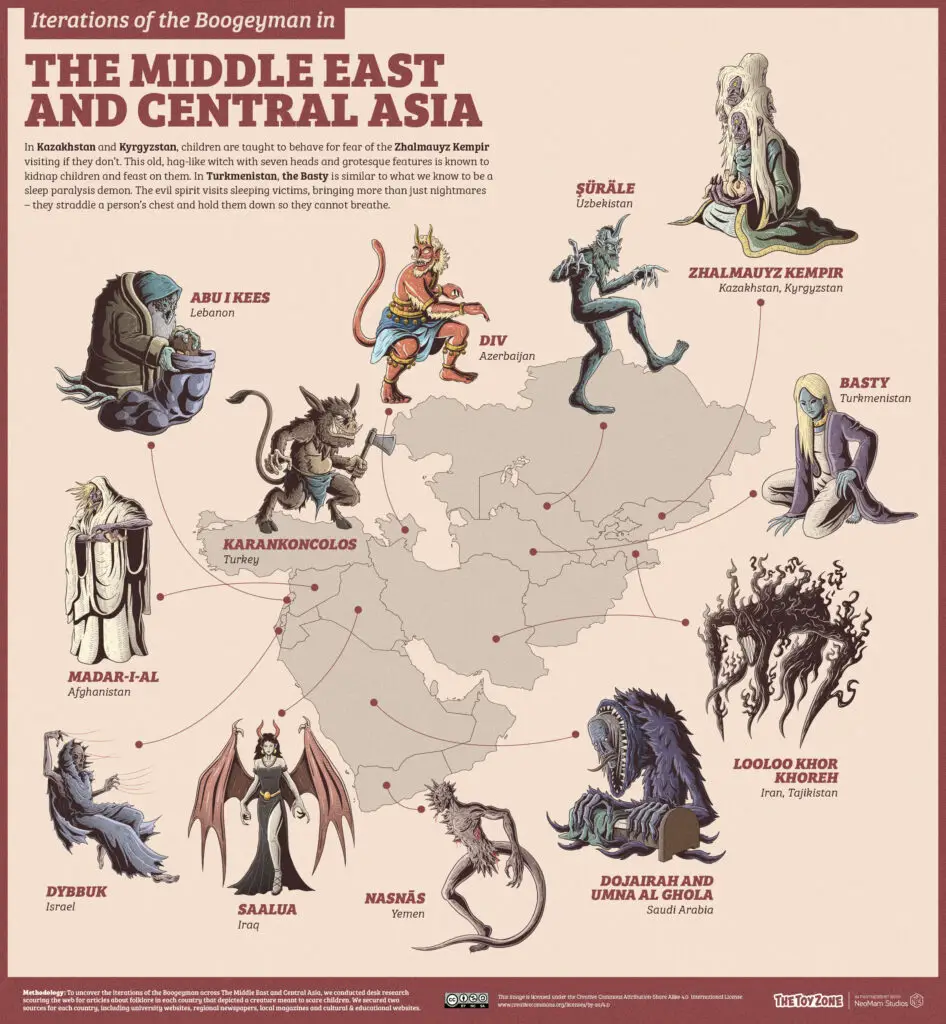
| Country | Boogeyman Name | Description |
|---|---|---|
| Afghanistan | Madar-i-Al | It is a nocturnal hag that kills infants in their cribs and is used by parents to frighten children into obedience. |
| Azerbaijan | Div | An islamic demon. They have the ability to shapeshift and do the opposite of what they are told. It eats children and tries to kidnap women to marry. Described as a giant human with horns and boar-like tusks. |
| Iran | Looloo Khor Khoreh | A story told by Persian parents to children that this monster would appear if they are misbehaving. A ghostly figure with no set characteristics or appearance. |
| Iraq | Saalua | A creature compared to a succubus, that’s half ghoul/half demon. It is used by parents to scare children but in other stories seduces men in cemeteries |
| Israel | Dybbuk | A ghostly demon who possesses people, from early Jewish mythology. It cleaves to the soul and causes mental degradation and madness. |
| Kazakhstan | Zhalmauyz Kempir | An old hag like witch with grotesque features. It sucks blood like a vampire and it kidnaps children. |
| Kyrgyzstan | Zhalmauyz Kempir | An old hag like witch with grotesque features. It sucks blood like a vampire and it kidnaps children. |
| Lebanon | Abu i Kees | Is depicted as an old man with a large sack that he uses to kidnap children who misbehave. |
| Saudi Arabia | Dojairah and Umna al Ghola | Meaning “Our mother the monster”. It’s part of a story used by parents to scare children. |
| Tajikistan | Looloo Khor Khoreh | A story told by Persian parents to children that this monster would appear if they are misbehaving. A ghostly figure with no set characteristics or appearance. |
| Turkey | Karankoncolos | A malevolent creature with thick fur. They would ask passers-by a question, the answer should be the word kara to prevent being attacked. |
| Turkmenistan | Basty | An evil spirit that straddles peoples chest while they sleep and holds them down so they cannot breathe while giving them bad dreams. A children’s story version of the sleep paralysis demon. |
| Uzbekistan | Surale | A creature that lives in forests. People warn of the §urale as it lures victims into a thicket and tickles them to death with its long arms and fingers. It also has a horn on its head. |
| Yemen | Nasnas | A shapeshifting Djinn (evil genie), that would disguise itself to lure unsuspecting people in. It would either drown you or strip you of your flesh. It serves as a warning to children to be vigilant. |
Rest of Asia and Oceania
Akin to the tale of Little Red Riding Hood, the frightful mythical creature that’s prominent in the nightmares of children in China and Taiwan is the Grandmother Tiger – a child-eating tiger that disguises itself as the child’s grandmother to gain their trust before eating them whole. In the Philippines, the Aswang is an evil shape-shifting monster that attacks at night, feeding on humans and replacing them with doppelgangers.
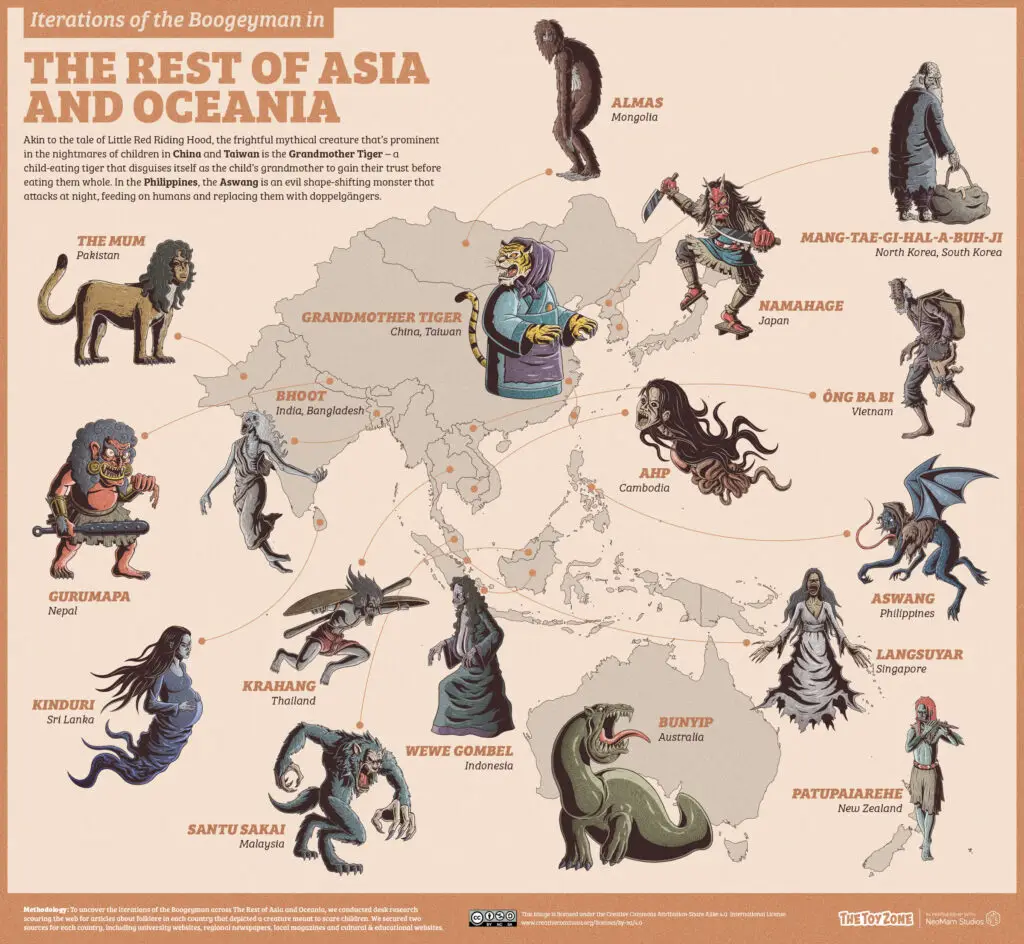
| Country | Boogeyman Name | Description |
|---|---|---|
| Australia | Bunyip | A creature from Aboriginal folklore. An amphibious water spirit that inhabited waterways and would attack women and children who got too close. Described as having a round head, an elongated neck, and a body resembling that of an ox, hippopotamus, ora manatee. |
| Bangladesh | Bhoot/Bhut | In Hindu mythology is a restless ghost that cannot touch the ground. Most common in the West Bengal region of Bangladesh. They have the ability to shapeshift and possess objects or living organisms. Appears as a human in white clothing. |
| Cambodia | Ahp | A shapeshifting flying witch. Appears as a normal villager during the day but at night flies around feasting on offal and corpses. If it eats the placenta from a pregnant woman, the Ahp will do terrible things to the mother and child. |
| China | Grandmother Tiger | A child eating Tiger, that would disguise itself as the child’s grandmother. |
| India | Bhoot/Bhut | In Hindu mythology is a restless ghost that cannot touch the ground. Most common in the West Bengal region of Bangladesh. They have the ability to shapeshift and possess objects or living organisms. Appears as a human in white clothing. |
| Indonesia | Wewe Gombel | A female ghost spirit who resides in the tops of palm trees. The spirit kidnaps children, but lovingly keeps mistreated children from neglectful parents. The story is told to stop children going out at night. |
| Japan | Namahage | An evil Yokai that looks similar to an Oni, with red/blue skin, long hair and lots of sharp teeth. Once a year, during the first full moon of the New Year they descend from the mountains to scare villagers. They brandish their knives looking for bad children. They particularly enjoy scaring small children and new brides. |
| Malaysia | Santu Sakai | A monstrous werewolf who feeds on human flesh. Native people warn visitors of the horror that is the Santu Sakai. |
| Mongolia | Almas | A hairy folk creature that lives in the Caucasus and Pamir Mountains of Central Asia and the Altai Mountains of western Mongolia. Those who still believe in the creature, scare children with the stories of the Almas. |
| Nepal | Gurumapa | A mythical creature banished to a field in Kathmandu after stealing and eating disobedient children. Described as an ugly-faced humanoid monster. |
| New Zealand | Patupaiarehe | In Maori folklore, these creatures are similar to western faye folk. They were afraid of light but would use flutes to lure people away and put spells on them. They are light or fair skinned with red hair. |
| North Korea | Mang-tae-gi-hal-a-buh-ji | Literal translation being Grandpa Net Bag. The story is that he will take and put disobedient children in his net bag. |
| Pakistan | The Mum/Mamma | A half human female/half hairy wild animal. The mum lived in the mountains of Quetta and would come prey on mischievous children and people who stay in the mountain range after sunset. |
| Philippines | Aswang | An evil shapeshifting monster. It shares traits with vampires, werewolves and ghouls. At night they attack and feed on people, replacing them with doppelgangers. Its appearance varies per region of the Philippines but does share characteristics with the previously mentioned monsters. |
| Singapore | Langsuyar | A beautiful woman who died during childbirth. She appears as a ghost and feasts on newborn children’s blood, mostly male. |
| South Korea | Mang-tae-gi-hal-a-buh-ji | Literal translation being Grandpa Net Bag. The story is that he will take and put disobedient children in his net bag. |
| Sri Lanka | Kinduri | A ghostly female spirit, disguised as a pregnant woman. She knocks on people’s houses at night, if a woman answers nothing happens, if a man answers he dies before sunrise. |
| Taiwan | Grandmother Tiger/Aunt Tiger/ Grandaunt Tiger | A child eating Tiger, that would disguise itself as the child’s grandmother. Serves as a warning to children to avoid strangers. |
| Thailand | Krahang | Is a shapeshifting creature who disguises himself as a villager during the day but at night flies around and terrorizes women and children. The male version of the Ahp (Krasue in Thai). |
| Vietnam | Ong Ba bi | A tall dark man who abducts naughty children and puts them in his 3 suitcases. Name means Mr Ba Be |
Africa
Children in South Africa and Lesotho might recall (or wish to forget) the Tokoloshe. Described as small humanoid gremlins, these creatures are malevolent and dangerous. Though sometimes they just like to cause a fright, they have also been known to choke children to death with their long, bony fingers while they sleep. In The Gambia and Senegal, the Ninki Nanka is a reptilian dragon creature that causes serious illness or death whenever it grazes against its victim.
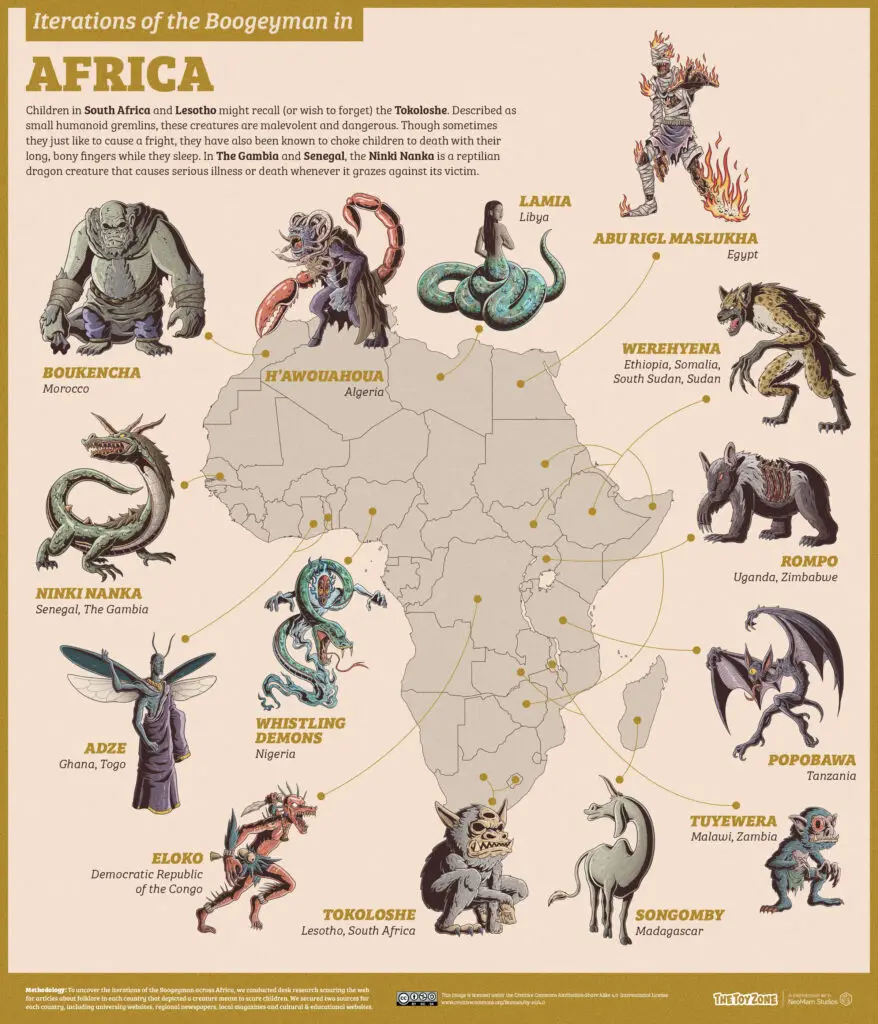
| Country | Boogeyman Name | Description |
|---|---|---|
| Algeria | H’awouahoua | A chimeric creature made up of the tail of a scorpion, one leg from a donkey, one leg from a panther, the claw of a lobster as a right hand, the hand of a monkey for a left hand, the chest of a turtle, the horns of a mountain goat and the face of an ape. It is used by Algerian parents to teach children to behave or it will steal them away and eat them. It apparently would use the child’s skin to repair its coat. |
| Congo (Democratic Republic of the) | Eloko | An old legend of Zaire told to children. Restless spirits of the dead, they carry magic bells that can paralyze a human and can swallow their victims whole |
| Congo (Republic of the) | Eloko | An old legend of Zaire told to children. Restless spirits of the dead, they carry magic bells that can paralyze a human and can swallow their victims whole |
| Egypt | Abu rigl maslukha | This creature’s name translates to ‘the man with the burnt leg’. The story of the Abu Rigl Maslukha is that it got burnt when it was a child because it did not listen to its parents. Now the monster hunts down naughty children to cook and eat them. |
| Ethiopia | Werehyena | Similar to a werewolf, a werehyena is a man who can turn into a hyena-like beast. Children are warned to stay away from blacksmiths as they are believed to always be werehyenas. |
| Ghana | Adze | A vampire-like creature of the Ewe people. Its preferred victims are young children. It will suck your blood and spread disease and can possess people turning them into witches. It usually appears as a firefly but becomes human when captured. |
| Lesotho | Tikoloshe/Tokoloshe | Described as a small humanoid gremlin. Malevolent and dangerous with some psychic abilities, at its most harmless it scares children, at its most dangerous it causes illness and even death to its victim. |
| Libya | Lamia | A child eating monster with the top half of a woman and the bottom half of a snake. Parents warn of the Lamia due to her obsession with children. Was a beautiful queen of Libya. |
| Madagascar | Songomby | A carnivorous creature resembling an Ox and a snake. Children were punished by putting them outside and telling them the songomby would eat them as it was lured by the child’s cries. |
| Malawi | Tuyewera | An impish creature with the power of invisibility that is used in witchcraft to steal or kill while its victims are asleep |
| Morocco | Boukencha | A story told to children of a monstrous ogre that would come for naughty children. |
| Nigeria | Whistling Demons | A legend told to children to never whistle at night or else demons and evil spirits will attack you. The demons don’t have any appearance or characteristics. |
| Senegal | Ninki Nanka | A reptilian-like dragon creature where gazing upon the monster ensures serious illness or death. |
| Somalia | Werehyena | Similar to a werewolf, a werehyena is a man who can turn into a hyena-like beast. Children are warned to not go out at night for fear of the werehyena. |
| South Africa | Tikoloshe/Tokoloshe | Described as a small humanoid gremlin. Malevolent and dangerous with some psychic abilities, at its most harmless it scares children, at its most dangerous it causes illness and even death to its victim. |
| South Sudan | Werehyena | Similar to a werewolf, a werehyena is a man who can turn into a hyena-like beast. Children are warned to not go out at night for fear of the werehyena. |
| Sudan | Werehyena | Similar to a werewolf, a werehyena is a man who can turn into a hyena-like beast. Children are warned to not go out at night for fear of the werehyena. |
| Tanzania | Popobawa | A shapeshifting bat that smells of sulfur. It attacks men, women and children during the night. |
| The Gambia | Ninki Nanka | A reptilian-like dragon creature where gazing upon the monster ensures serious illness or death. |
| Togo | Adze | A vampire-like creature of the Ewe people. Its preferred victims are young children. It will suck your blood and spread disease and can possess people turning them into witches. It usually appears as a firefly but becomes human when captured. |
| Uganda | Rompo | A mythical beast with a hare head and a badger body and bear legs. It feasts on human flesh and is found in graveyards. |
| Zambia | Tuyewera | An impish creature with the power of invisibility that is used in witchcraft to steal or kill while its victims are asleep |
The Methodology Behind This Study
To find out how iterations of the Boogeyman vary in every country worldwide, The TheToyZone team conducted desk research where they found existing articles of folklore in each nation that depict a mythical creature meant to scare kids.
For this research, they defined the Boogeyman as a creature that parents tell stories about to kids to keep them from misbehaving, naughtiness or doing things that may bring harm to them. If a nation has multiple mythical creatures fitting this, either the creature that most closely matches this description will be chosen or the more well-known and famous creature of legend. If a nation doesn’t have a monster that perfectly matched this description, the team chose a creature from the local folktales that was known for being frightening to or targeting children.
Some creatures will transcend countries because to similar cultures. In this case, the team conducted further research to identify alternative Boogeyman figures. Where no other mythical creature that corresponds to the Boogeyman description was found, then the original Boogeyman that was found in other nations was used.
The research process prioritized high-quality sources as reference material for the Boogeyman, and the TheToyZone team identified these sources primarily through Google Search, using specific keywords such as ‘Boogeyman in X country/culture/folklore’ and ‘X country folklore creatures/monsters.’

